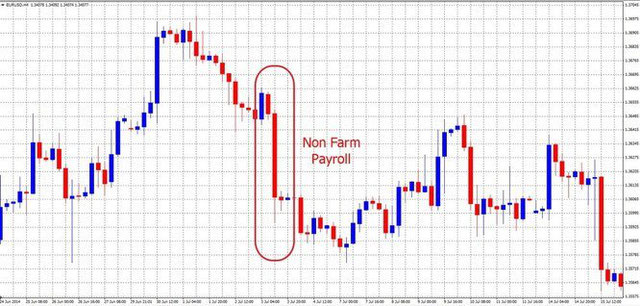
Brief Summary: The nonfarm payrolls figure released by the US Department of Labor presents the number of new jobs created during the previous month, in all non-agricultural business, within the States.
The payrolls figure can change significantly month on month, due to its high correlation with economic policy decisions made by the US Central Bank. The published number is closely watched by traders, and changes in their opinions tends to trigger volatility in the markets. Generally speaking, a high reading is seen as positive for the US economy, while a low reading is seen as negative.

Whether you’re a fundamental trader or primarily rely on technicals, the NFP report regularly creates large price-movements in the market that can affect your trading performance. Occasionally, the report can send shockwaves through the market if the actual number significantly differs from market expectations.
Understanding the NFP report and its details can have a tremendous impact on your bottom line. In this article, we’ll cover what NFP stands for, why it is so important, and how to trade it.
Why is NFP Important?
The non-farm payroll (NFP) report is a key economic report for the FX market. The headline number represents the number of added jobs over a month, excluding farm jobs, government jobs, employees of NGOs, and private household employees.
As such, the NFP report shows the strength of the US labour market over a given month and often creates enormous volatility in the currency market. The Federal Reserve follows the report closely to determine future adjustments to its monetary policy. A better-than-expected NFP report could signal that the economy is overheating and that the Fed needs to tighten monetary policy, i.e. hike interest rates, to cool the economy down.
Conversely, a lower-than-expected NFP number signals that the US labour market struggles and that the Fed could cut interest rates to support the economy. Besides the headline number, i.e. the number of new jobs added to the US economy, the report also includes two additional important numbers – the average hourly earnings and the unemployment rate.
Many market participants, traders, investors, and financial institutions around the world follow the report and base their trading decisions on its outcome. Understanding the NFP report can help Forex traders to take advantage of the large price swings caused by the report. The report can be successfully traded with simple technical tools on short-term timeframes, such as the 5-minute or 15-minute ones.
When is NFP Released?
The NFP number represents a part of the monthly US employment report, released at 8:30 a.m. Eastern Time (13:30 p.m. London time) on each first Friday of the month by the US Bureau of Labor Statistics. The only exception is when the first Friday falls on a major US holiday, such as the New Year when the report is postponed to the next Friday.
NFP Data: The Headline Number and Details
The US labor market report includes three major categories: the non-farm payrolls number, the average hourly earnings, and the unemployment rate. The NFP number is considered the most important release and the headline number of the monthly report, with many traders focusing solely on the NFP number.
The average hourly earnings report shows how much hourly earnings have changed during the previous month, in percentage terms. If the average hourly earnings are above market expectations, this usually signals that inflationary pressures could be building up and that the Fed could respond with a rate hike, supporting the US dollar. Similarly, if the average hourly earnings fall below expectations, this signals that the Fed could adopt a looser monetary policy and drive the US dollar down.
The unemployment rate shows the percentage of unemployed people during the previous month as a percentage of the total workforce. Just like with the other reports, a falling unemployment rate (better than expected) could support the US dollar, and a rising unemployment rate (lower than expected) could send the US dollar down as Fed easing bets increase. While the NFP number is considered the most important report out of those three, many Forex traders make the mistake to completely neglect the average hourly earnings and the unemployment rate when trading the US labour market report.
If the NFP number comes above market expectations but the details of the report are weak (hourly earnings and unemployment), then the US dollar could make an initial spike as algos try to take advantage of the headline number, only to completely reverse to its previous trading levels in the coming minutes. That’s why you should always pay attention to the complete report and read through all of its details before placing a trade based on the NFP.
Which Pairs Are Most Affected?
The pairs that are most affected by the NFP report are pairs that include the US dollar as either the base currency or the counter currency. This includes EUR/USD, GBP/USD, USD/CAD, and USD/JPY, to name a few.
Before placing a trade, measure the average volatility of the pair you’re trading for previous NFP releases, and adjust your stop-loss and profit-targets accordingly. It doesn’t make sense to use the same stop-loss size for USD/CAD and GBP/USD, for example, as the volatility of GBP/USD is quite higher.
Since the NFP report is a widely-followed report, it doesn’t impact only the US dollar. Often, other currencies will also exhibit increased volatility right after the release of the NFP report.
Other Important Labour Reports
Besides the non-farm payrolls, traders and investors also follow other job-related indicators that may also lead to increased volatility in the markets. Since the Fed is closely following the labour market when making changes to interest rates, all job-related reports can impact the US dollar.
The ADP payrolls report is released in the same week as the NFP report, but on Wednesday – two days before the NFP. The report reveals important information about the health of the US labour market before the widely-followed NFP release.
However, bear in mind that those reports are not correlated: It’s not unusual that the ADP beats market expectations but the NFP comes in lower than expected, and vice-versa. Automatic Data Processing Inc. (ADP) is a firm that handles payroll data for about 20% of US private employment, giving the firm insight into the health and trends of the US labour market.
Final Words
The non-farm payroll report (NFP) is a key economic indicator that reveals important information about the health of the US labour market. The report is widely followed by all types of market participants, including retail traders, investors, hedge funds, and even the Federal Reserve which makes adjustments to its monetary policy based on the trend in the NFP. The report is released each first Friday of a month by the US Bureau of Labor Statistics, at 8:30 a.m. Eastern Time.
The headline number shows the number of added jobs to the US economy during the previous month, excluding farm employees, private household employees, and government jobs. To take the most advantage of the report, traders also need to follow the details of the report, including the average hourly earnings and the monthly unemployment rate.
If you decide to trade the actual news release, make sure to always use stop-losses and be prepared for large price movements immediately after the release. The volatility can often cause slippage and higher spreads, which are some drawbacks you need to pay attention to.
All my developments: https://www.mql5.com/en/users/genino/seller
Subscribe to my channel , there will be a lot of useful information : https://www.mql5.com/en/channels/01132123b27ed901

